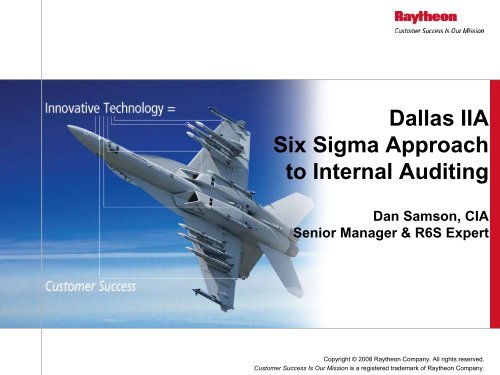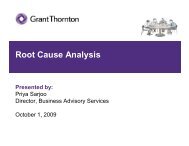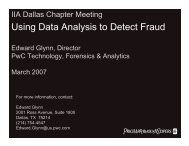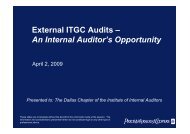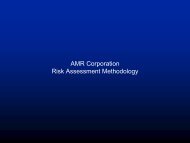Six Sigma Approach to Internal Auditing - IIA Dallas Chapter
Six Sigma Approach to Internal Auditing - IIA Dallas Chapter
Six Sigma Approach to Internal Auditing - IIA Dallas Chapter
Create successful ePaper yourself
Turn your PDF publications into a flip-book with our unique Google optimized e-Paper software.
<strong>Dallas</strong> <strong>IIA</strong><br />
<strong>Six</strong> <strong>Sigma</strong> <strong>Approach</strong><br />
<strong>to</strong> <strong>Internal</strong> <strong>Auditing</strong><br />
Dan Samson, CIA<br />
Senior Manager & R6S Expert<br />
Copyright © 2008 Raytheon Company. All rights reserved.<br />
Cus<strong>to</strong>mer Success Is Our Mission is a registered trademark of Raytheon Company.
Index<br />
• Introductions<br />
• <strong>Six</strong> <strong>Sigma</strong>: Brief His<strong>to</strong>ry<br />
• <strong>Six</strong> <strong>Sigma</strong> at Raytheon<br />
• Raytheon <strong>Internal</strong> Audit Overview<br />
• How <strong>Six</strong> <strong>Sigma</strong> Transformed <strong>Internal</strong> Audit<br />
• Alignment of Audit Process with <strong>Six</strong> Steps<br />
• Results: Pre & Post <strong>Six</strong> <strong>Sigma</strong>
Raytheon Overview<br />
• Leading edge aerospace & defense company<br />
• $22B sales for 2007<br />
• 72,000 employees<br />
• <strong>Six</strong> businesses<br />
– Intelligence & Information Systems (<strong>Dallas</strong>)<br />
– Network Centric Systems (<strong>Dallas</strong>)<br />
– Raytheon Missile Systems (Tucson)<br />
– Space & Airborne Systems (LA)<br />
– Integrated Defense Systems (Bos<strong>to</strong>n)<br />
– Raytheon Technical Services (Washing<strong>to</strong>n DC)
<strong>Six</strong> <strong>Sigma</strong>: Brief His<strong>to</strong>ry<br />
The classical 6 <strong>Sigma</strong> approach, developed by Mo<strong>to</strong>rola, has underpinnings<br />
in producible Hardware design and manufacture.<br />
• Ability <strong>to</strong> reproduce units of product identically and without waste<br />
• Statistical focus; 6 sigma process = only 3.4 defects/million opportunities<br />
The Raytheon <strong>Six</strong> <strong>Sigma</strong> <strong>Approach</strong> is based on benchmarking<br />
with Allied Signal and General Electric and is broader in scope<br />
• R6S Umbrella = rigorous approach <strong>to</strong> problem solving using a 6-step process<br />
• Philosophy of continuous improvement, including throughput improvement and<br />
defect / cycle time reduction in all business processes and products<br />
• Integrates Proven Philosophies and a Number of Continuous Improvement<br />
Techniques and Tools<br />
• Supported by a full time <strong>Six</strong> <strong>Sigma</strong> Expert Network<br />
• Focused on Cus<strong>to</strong>mer and Value Stream<br />
• Leads <strong>to</strong> a Culture Change
<strong>Six</strong> <strong>Sigma</strong>: Brief His<strong>to</strong>ry<br />
A Knowledge-Based Process for Transforming Our Culture <strong>to</strong><br />
Maximize Cus<strong>to</strong>mer Value and Grow our Business<br />
Visualize<br />
Act based on facts, not opinions<br />
• Get data, turn in<strong>to</strong> information<br />
Achieve<br />
Commit<br />
• Take information, transform in<strong>to</strong><br />
new useful knowledge<br />
• Take knowledge, and share <strong>to</strong><br />
create lasting improvements<br />
Improve<br />
Prioritize<br />
Characterize
<strong>Six</strong> <strong>Sigma</strong> at Raytheon<br />
Raytheon <strong>Six</strong> <strong>Sigma</strong><br />
is at the center of all of<br />
our efforts:<br />
Successful deployment<br />
across all business units<br />
• Creating Value for<br />
our Cus<strong>to</strong>mers<br />
• Becoming One<br />
Company<br />
• Using Common<br />
Processes and<br />
Tools<br />
Alignment<br />
Leadership<br />
• Fully supported, from the<br />
<strong>to</strong>p down<br />
• Aligned with<br />
Business Goals<br />
Involvement<br />
It defines our culture — how we work<br />
It defines our culture — how we work
<strong>Six</strong> <strong>Sigma</strong> at Raytheon<br />
<strong>Sigma</strong> Quality Level:<br />
The Higher the <strong>Sigma</strong> level, the Better the Quality<br />
Three <strong>Sigma</strong> Process<br />
<strong>Six</strong> <strong>Sigma</strong> Process<br />
LSL<br />
USL<br />
LSL<br />
USL<br />
-6σ -3σ 0 +3σ +6σ<br />
LSL: Lower Specification Limit<br />
USL: Upper Specification Limit<br />
σ: measure of variation in a process<br />
Specs are Cus<strong>to</strong>mer Driven<br />
-6σ -3σ 0 +3σ +6σ<br />
Reducing Variation = Reduces Waste Waste<br />
Lowers Cost! Cost!
<strong>Six</strong> <strong>Sigma</strong> at Raytheon<br />
3 <strong>Sigma</strong> Process vs. 6 <strong>Sigma</strong> Process<br />
3 sigma level 99.73% 6 sigma level 99.99966%<br />
8.1 Million wrong drug<br />
prescriptions a year worldwide<br />
10,000 wrong drug<br />
prescriptions a year worldwide<br />
Three <strong>Sigma</strong> = 99.73% right or<br />
2,700 PPM defects (no shift)<br />
Over 11,000 newborn babies<br />
accidentally dropped by nurses<br />
or doc<strong>to</strong>rs in USA each year<br />
<strong>Six</strong> short or long landings at<br />
Atlanta International Airport<br />
each day<br />
Almost 500 incorrect surgical<br />
operations each week<br />
Thirteen newborn babies<br />
accidentally dropped by nurses<br />
or doc<strong>to</strong>rs in USA each year<br />
Three short or long landings at<br />
Atlanta International Airport in a<br />
year<br />
One incorrect surgical<br />
operation every two weeks<br />
<strong>Six</strong> <strong>Sigma</strong> = 99.99966% right or<br />
3.4 defects per million (with shift)
<strong>Six</strong> <strong>Sigma</strong> at Raytheon<br />
• The bot<strong>to</strong>m line:<br />
– Improved manufacturing processes<br />
– Minimal defects = NO DOUBT about our product working<br />
– Growth opportunities enabled!<br />
– Knowledge sharing, best practice, constant improvement<br />
– $1B in savings attributed <strong>to</strong> <strong>Six</strong> <strong>Sigma</strong> since 1999<br />
– Wall Street “Gets it”, real advantage over competition
Raytheon <strong>Internal</strong> Audit Overview<br />
• Larry Harring<strong>to</strong>n, CAE, reports <strong>to</strong> CEO and Audit Committee<br />
of Board of Direc<strong>to</strong>rs<br />
• Yosief Ghirmai, West Region Direc<strong>to</strong>r<br />
• Leading edge practice<br />
• Organization of 43<br />
– 35 Raytheon employees<br />
• East/West Coast Direc<strong>to</strong>rs<br />
• Senior Managers for each office<br />
– 8 Ernst & Young co-source<br />
• Five offices aligned with our six businesses<br />
• ~45 projects/year + management special requests<br />
• ~90% annual internal retention rate – best in class
How <strong>Six</strong> <strong>Sigma</strong> Transformed <strong>Internal</strong> Audit<br />
• IA previously outsourced <strong>to</strong> Big 4<br />
• Strong stature and independence<br />
• Completed comprehensive and exhaustive diagnostic on<br />
current state of organization<br />
– Structure<br />
– Staff experience, competency models, mix<br />
– Repeatable Process/Framework<br />
• Harring<strong>to</strong>n hired Kathryn Bingham, R6S Expert (Black Belt)<br />
<strong>to</strong> facilitate transformation<br />
• Instituted <strong>Six</strong> <strong>Sigma</strong> Methodology<br />
– Repeatable problem solving methodology that addresses root cause<br />
– Common language of business partners
How <strong>Six</strong> <strong>Sigma</strong> Transformed <strong>Internal</strong> Audit<br />
• <strong>Internal</strong> Audit Methodology Development<br />
– Aligned <strong>to</strong> Company’s <strong>Six</strong> <strong>Sigma</strong> Methodology and Integrated Product<br />
Development System (IPDS)<br />
– Audit cycles have Steps, Gates, and Phases<br />
– Planning Checklist<br />
– Reporting Checklist<br />
• Enables delivery of value <strong>to</strong> stakeholders beyond assurance<br />
services<br />
• Its all about the Current State vs. the Future State!
How <strong>Six</strong> <strong>Sigma</strong> Transformed <strong>Internal</strong> Audit<br />
• Audit Planning<br />
– Establish the Burning Platform<br />
• What is the REAL burning need for this audit<br />
• Why is it on the plan<br />
• Understand the real reasons and motivations and educate your teams!<br />
• Data – validate the burning platform with business/process/organizational<br />
data not just anecdotal information<br />
• The Burning Platform is the basis for the business case in the Engagement<br />
Letter, the background of the report, and for influencing without power<br />
• Need <strong>to</strong> translate <strong>to</strong> language of our business partners
Audit Process – Visualize/Audit Planning<br />
IPO - Visualize<br />
Inputs<br />
Current state<br />
Clear & pressing need<br />
for change<br />
Stakeholder demand<br />
Cus<strong>to</strong>mer perceptions<br />
& desires<br />
Market position<br />
& pressures<br />
Aspirations, Values, Goals<br />
Process<br />
1)<br />
1)<br />
Assess<br />
Assess<br />
the<br />
the<br />
current<br />
current<br />
state.<br />
state.<br />
2)<br />
2)<br />
Visualize<br />
Visualize<br />
alternate<br />
alternate<br />
future<br />
future<br />
states<br />
states<br />
“blue<br />
“blue<br />
sky”<br />
sky”<br />
with<br />
with<br />
stakeholders.<br />
stakeholders.<br />
3)<br />
3)<br />
Converge<br />
Converge<br />
<strong>to</strong><br />
<strong>to</strong><br />
a<br />
a<br />
common<br />
common<br />
vision<br />
vision<br />
&<br />
validate<br />
validate<br />
(create<br />
(create<br />
need<br />
need<br />
& generate<br />
generate<br />
excitement).<br />
excitement).<br />
4)<br />
4)<br />
Draw<br />
Draw<br />
the<br />
the<br />
mental<br />
mental<br />
image<br />
image<br />
that<br />
that<br />
excites<br />
excites<br />
people<br />
people<br />
and<br />
and<br />
creates<br />
creates<br />
a<br />
a<br />
need<br />
need<br />
for<br />
for<br />
change<br />
change<br />
that<br />
that<br />
demonstrates<br />
demonstrates<br />
it.<br />
it.<br />
5)<br />
5)<br />
Align<br />
Align<br />
and<br />
and<br />
validate<br />
validate<br />
throughout<br />
throughout<br />
the<br />
the<br />
value<br />
value<br />
stream:<br />
stream:<br />
•<br />
•<br />
Cus<strong>to</strong>mer<br />
Cus<strong>to</strong>mer<br />
•<br />
•<br />
Employees<br />
Employees<br />
•<br />
•<br />
Suppliers<br />
Suppliers<br />
•<br />
•<br />
Shareholders<br />
Shareholders<br />
6)<br />
6)<br />
Develop<br />
Develop<br />
strategy<br />
strategy<br />
(1st<br />
(1st<br />
steps):<br />
steps):<br />
•<br />
•<br />
Identify<br />
Identify<br />
Sponsor/Change<br />
Sponsor/Change<br />
Agent<br />
Agent<br />
Outputs<br />
Vision of the Future<br />
Need for Change<br />
Objectives<br />
Accountable<br />
Stakeholders
Audit Process – Visualize/Audit Planning<br />
Cont.<br />
• Visualize the Future<br />
– What is the ideal state of the business/function/process that we are<br />
auditing<br />
– How does ideal state look in terms of performance, structure, <strong>to</strong>ols,<br />
systems, people, controls, risk mitigation<br />
– Collaborate with business stakeholders <strong>to</strong> determine vision statement if<br />
one does not exist. Leverage existing mission statements <strong>to</strong><br />
understand ideal state.<br />
– Partner with stakeholders <strong>to</strong> facilitate building vision statement<br />
Vision = Focus
Audit Process – Commit/Audit Planning<br />
IPO – Commit: “Commit <strong>to</strong> Change”<br />
Inputs<br />
Process<br />
Outputs<br />
Vision of the Future<br />
Need for Change<br />
Objectives<br />
Accountable Stakeholders<br />
1) 1) Business Business Cus<strong>to</strong>mer Cus<strong>to</strong>mer personalizes<br />
vision, vision, agrees agrees that that there’s there’s a need, need,<br />
accepts accepts the the strategy strategy & commits commits <strong>to</strong> <strong>to</strong><br />
change. change.<br />
2) 2) Characterizes a multifunctional<br />
team team & captures captures resources. resources.<br />
3) 3) Team Team personalizes vision vision by by<br />
exploring, exploring, understanding &<br />
accepting accepting what’s what’s in in it it for for them them &<br />
their their organization.<br />
4) 4) Team Team education education in in Raytheon Raytheon <strong>Six</strong>- <strong>Six</strong>-<br />
<strong>Sigma</strong> <strong>Sigma</strong> Process. Process.<br />
5) 5) Team Team validates validates need need <strong>to</strong> <strong>to</strong> change change &<br />
translates translates vision vision in<strong>to</strong> in<strong>to</strong> goals goals &<br />
objectives. objectives.<br />
6) 6) Team Team identifies identifies target target areas areas &<br />
shares shares need need <strong>to</strong> <strong>to</strong> change change with with them. them.<br />
Committed Stakeholders<br />
Committed, aligned &<br />
knowledgeable team<br />
Identified & Informed<br />
Target Areas<br />
Defined Goals &<br />
Objectives
Audit Process – Commit/Audit Planning<br />
Cont.<br />
• Commit<br />
– Build your foundation, weak stakeholder commitment = audit failure<br />
– Do you know who your stakeholders really are<br />
• Develop “Responsible, Accountable, Supporting, Consult, and Inform” or<br />
“RASCI” Chart.<br />
• Use your network – Conduct Force Field Analysis<br />
• Gather some intelligence<br />
– Gain commitment from your team<br />
• How was the team assembled<br />
• Are competencies appropriate<br />
• Are they empowered<br />
– Team Contract for Change and Commitment<br />
Commitment = Success
Audit Process – Prioritize/Planning/<br />
Fieldwork<br />
IPO - Prioritize<br />
“Determine Improvement Priorities”<br />
Inputs<br />
Process<br />
Outputs<br />
Committed Stakeholders<br />
Committed, aligned &<br />
knowledgeable team<br />
Identified & Informed<br />
Target Areas<br />
Defined Goals &<br />
Objectives<br />
1)<br />
1)<br />
Understand<br />
Understand<br />
Value<br />
Value<br />
Stream.<br />
Stream.<br />
2)<br />
2)<br />
Perform<br />
Perform<br />
Assessment(s).<br />
Assessment(s).<br />
3)<br />
3)<br />
Identify<br />
Identify<br />
opportunities/highopportunities/highleverage<br />
leverage<br />
points:<br />
points:<br />
4)<br />
4)<br />
Prioritize<br />
Prioritize<br />
Risks<br />
Risks<br />
& Opportunities.<br />
Opportunities.<br />
5)<br />
5)<br />
Document<br />
Document<br />
improvement<br />
improvement<br />
plan<br />
plan<br />
6)<br />
6)<br />
Obtain<br />
Obtain<br />
commitment<br />
commitment<br />
<strong>to</strong><br />
<strong>to</strong><br />
support<br />
support<br />
plan<br />
plan<br />
(Contract<br />
(Contract<br />
for<br />
for<br />
Change).<br />
Change).<br />
Prioritized list of<br />
Risks<br />
Contract for change<br />
Transferred knowledge
Audit Process – Prioritize/Planning/<br />
Fieldwork Cont.<br />
• Prioritize<br />
– Gather data on current state of process<br />
Tools: Stakeholder Analysis,<br />
Facilitation, Prioritize – IPO,<br />
Pare<strong>to</strong> Charts, Team Building<br />
– What are the Undesirable Effects that need <strong>to</strong> be addressed<br />
• UDEs can be unmitigated risks, performance issues, known problems, etc<br />
– What are the Desirable Effects that should be maintained<br />
– Prioritize Undesirable Effects <strong>to</strong> be addressed based on surveys,<br />
interviews, etc<br />
Prioritization = Value
Audit Process – Prioritize/Planning/<br />
Fieldwork Cont.<br />
• Prioritize<br />
– Evaluate other potential risks<br />
– Develop numerical risk ranking based on likelihood of occurrence and<br />
impact ($$$). Provide substantiation for basis of ranking.<br />
– Communicate via Heat Map for effectiveness<br />
– Validate, validate, validate!<br />
– Identify consulting/non-audit opportunities
Audit Process – Prioritize/Planning/<br />
Fieldwork Cont.<br />
Some audit departments may make recommendations at this<br />
point.<br />
<strong>Six</strong> <strong>Sigma</strong> mandates solutions driven by data and true root<br />
causes!
Audit Process – Characterize/Fieldwork<br />
Characterize – IPO<br />
Inputs<br />
Process<br />
Outputs<br />
Prioritized list of<br />
Risks<br />
Contract for Change<br />
Transferred Knowledge<br />
1) 1) Understand (Characterize) the the<br />
Process, Process, including including root root causes. causes.<br />
2) 2) Translate Translate in<strong>to</strong> in<strong>to</strong> an an Improvement Plan. Plan.<br />
3) 3) Communicate the the Improvement Plan. Plan.<br />
Allocated Resources<br />
Characterized Process<br />
Documented Expectations<br />
with expected Benefits &<br />
Improvements<br />
Transferred Knowledge
Audit Process – Characterize/Fieldwork<br />
Cont.<br />
• Characterize<br />
– Data Collection and Analysis:<br />
• Revalidate process with contacts<br />
Tools: Process Maps,<br />
Interrelationship Diagrams, Value<br />
Add Analysis; Apollo Root Cause<br />
• Sample selection, perform tests, document results<br />
• Validation of observations; clarify / review as needed<br />
• Evaluate effectiveness of controls at mitigating identified risk<br />
• Raise issues and resolve with management
Audit Process – Characterize/Fieldwork<br />
Cont.<br />
• Characterize<br />
– Data Collection and Analysis:<br />
• Identify best practices, Opportunities and Risks<br />
• Define root causes<br />
• What do observations imply regarding Raytheon Cus<strong>to</strong>mer value stream<br />
(waste / variation)<br />
• Identify improvement alternatives
Audit Process – Characterize/Fieldwork<br />
Cont.<br />
• Characterize<br />
– Example: document/validate process<br />
• Process Maps: controls, hand-offs, duplicate reviews, rework loops<br />
RTSC ISS<br />
GATE 4 – GATE 5 PROCESSES<br />
D<br />
“Start<br />
Gate 5”<br />
PM takes lead –<br />
holds kickoff<br />
meeting <strong>to</strong><br />
discuss cus<strong>to</strong>mer<br />
requirements<br />
Review and<br />
address action<br />
items from Gate 4<br />
PM addresses<br />
negotiated<br />
changes<br />
PM Reconciles<br />
proposal vs.<br />
baseline<br />
PM creates IMP/<br />
IMS with input<br />
from contracts<br />
No<br />
Back <strong>to</strong> PM/CBT<br />
for rework<br />
End<br />
Yes<br />
OK<br />
Gate 5 Review/<br />
Approval<br />
PM Compiles<br />
Gate 5 package<br />
with inputs from<br />
CBTs<br />
Gate 5 planning<br />
process begins<br />
with CBTs (tailors<br />
packages <strong>to</strong><br />
program)<br />
CONTROL<br />
CONTROL WEAKNESS<br />
CONTROL ABSENCE<br />
ACTIVITY<br />
POTENTIAL NVA OPPORTUNITY<br />
RISK AREA<br />
CREATED BY RAYTHEON INTERNAL AUDIT, AUGUST 2007
Audit Process – Characterize/Fieldwork<br />
Cont.<br />
• Characterize<br />
– Example: Determining Causal Relationships<br />
<br />
Interrelationship Diagram<br />
• Identifies drivers of Undesirable Effects <strong>to</strong> determine initial causal<br />
relationships.
Audit Process – Characterize/Fieldwork<br />
Cont.<br />
• Characterize<br />
Example: Apollo Root Cause<br />
• No such thing as a ‘root cause’<br />
• Every effect has at least one<br />
action cause and one condition<br />
cause that exist at the same<br />
time<br />
• Causes are effects of other<br />
causes – a cause and effect<br />
continuum exists<br />
• Start at the undesirable end<br />
and work backwards through<br />
all relevant causal legs<br />
• Focus on interrelationships<br />
between causes and effects <strong>to</strong><br />
identify opportunities for effective<br />
solutions<br />
• Alignment around the problem and<br />
the significance<br />
• Incorporates key cause and effect<br />
principles<br />
• Use of evidence <strong>to</strong> validate causes<br />
• Effectiveness of solutions<br />
dependent on degree of<br />
acceptable risk
Audit Process –<br />
Improve/Fieldwork/Reporting<br />
Improve – IPO<br />
Inputs<br />
Process<br />
Outputs<br />
Allocated Resources<br />
Characterized Process<br />
Documented Expectations<br />
with expected Benefits &<br />
Improvements<br />
Transferred Knowledge<br />
1)<br />
1)<br />
Identify<br />
Identify<br />
Resources…<br />
Resources…<br />
train/educate<br />
train/educate<br />
as<br />
as<br />
necessary.<br />
necessary.<br />
2)<br />
2)<br />
Detail<br />
Detail<br />
Action<br />
Action<br />
Plan<br />
Plan<br />
and<br />
and<br />
Schedule.<br />
Schedule.<br />
3)<br />
3)<br />
Pull<br />
Pull<br />
in<br />
in<br />
required<br />
required<br />
Tools.<br />
Tools.<br />
4)<br />
4)<br />
Collaborate<br />
Collaborate<br />
on<br />
on<br />
solution.<br />
solution.<br />
5)<br />
5)<br />
Moni<strong>to</strong>r<br />
Moni<strong>to</strong>r<br />
Progress.<br />
Progress.<br />
6)<br />
6)<br />
Measure<br />
Measure<br />
Results.<br />
Results.<br />
Management &<br />
Control Systems<br />
Improved Process<br />
Performance<br />
Transferred Knowledge
Audit Process –<br />
Improve/Fieldwork/Reporting Cont.<br />
• Improve<br />
– Stakeholder Review:<br />
• Document testing exceptions/Validate<br />
Tools: Force Field Analysis,<br />
Facilitation,<br />
• Out brief on findings, including items discussed / cleared during audit<br />
• Review process improvement opportunities<br />
• Review preliminary management responses<br />
• Prepare Draft Report<br />
• Distribute draft with findings and management action plan <strong>to</strong> BU leadership<br />
prior <strong>to</strong> final distribution
Audit Process – Achieve/Reporting<br />
Achieve – IPO<br />
Inputs<br />
Management &<br />
Control Systems<br />
Improved Process<br />
Performance<br />
Transferred<br />
Knowledge<br />
Process<br />
1)<br />
1)<br />
Continue<br />
Continue<br />
Collaboration/Partnership<br />
Collaboration/Partnership<br />
2)<br />
2)<br />
Distribute<br />
Distribute<br />
Report<br />
Report<br />
3)<br />
3)<br />
Measure<br />
Measure<br />
and<br />
and<br />
compare<br />
compare<br />
results<br />
results<br />
and<br />
and<br />
expectations…<br />
expectations…<br />
take<br />
take<br />
appropriate<br />
appropriate<br />
action.<br />
action.<br />
4)<br />
4)<br />
Create<br />
Create<br />
Success<br />
Success<br />
Summary.<br />
Summary.<br />
5)<br />
5)<br />
Reward<br />
Reward<br />
& recognize<br />
recognize<br />
change<br />
change<br />
agent<br />
agent<br />
team.<br />
team.<br />
6)<br />
6)<br />
Capture<br />
Capture<br />
& Share<br />
Share<br />
knowledge.<br />
knowledge.<br />
7)<br />
7)<br />
Moni<strong>to</strong>r<br />
Moni<strong>to</strong>r<br />
and<br />
and<br />
analyze<br />
analyze<br />
process<br />
process<br />
for<br />
for<br />
Continuous<br />
Continuous<br />
Improvement<br />
Improvement<br />
Opportunities.<br />
Opportunities.<br />
Outputs<br />
Embedded New Process<br />
Delivered Results<br />
<strong>to</strong> the Organization<br />
Documented Success:<br />
• Case Study<br />
• Lessons Learned<br />
• Next Steps<br />
Recognition & Rewards<br />
Captured & Shared<br />
Knowledge
Audit Process – Achieve/Reporting<br />
Cont.<br />
• Achieve<br />
– Final Report:<br />
• Issue final report<br />
Tools: Survey, Reporting<br />
• Request survey feedback on cus<strong>to</strong>mer satisfaction
Results<br />
Pre-<strong>Six</strong> <strong>Sigma</strong><br />
• Audit report issuance cycle >180<br />
days<br />
• Business stakeholder<br />
dissatisfaction<br />
• Addressing anecdotal/symp<strong>to</strong>matic<br />
causes not root causes<br />
• Very high turn over of staff<br />
• Lack of institutional knowledge<br />
• No repeatable process<br />
• Weak methodology<br />
• Not used as talent pool<br />
Post-<strong>Six</strong> <strong>Sigma</strong><br />
• Report issuance ~ 2 weeks<br />
• High stakeholder satisfaction<br />
(average score 4.4 out of 5)<br />
• Address true root causes<br />
• Low external turnover<br />
• Process for sharing and retaining<br />
knowledge<br />
• Repeatable process for analyzing<br />
and mitigating business risk<br />
• Leveraged as talent pool by mgmt<br />
• Enable business growth<br />
• Constant reassessment & change
Results<br />
• Affect Company Strategy<br />
• Multi Million $ Savings<br />
• Benchmarking<br />
• Lead Efficiency/Lean Efforts<br />
• Policy Guidance<br />
• Change Agents<br />
• Problem Solvers<br />
• Consultants
Q&A
Dan Samson<br />
Daniel_A_Samson@Raytheon.com<br />
617.281.4711


